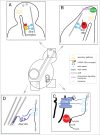Here, there, everywhere. mRNA localization in budding yeast
- PMID: 25482891
- PMCID: PMC4615570
- DOI: 10.4161/rna.29945
Here, there, everywhere. mRNA localization in budding yeast
Abstract
mRNA localization and localized translation is a common mechanism that contributes to cell polarity and cellular asymmetry. In metazoan, mRNA transport participates in embryonic axis determination and neuronal plasticity. Since the mRNA localization process and its molecular machinery are rather complex in higher eukaryotes, the unicellular yeast Saccharomyces cerevisiae has become an attractive model to study mRNA localization. Although the focus has so far been on the mechanism of ASH1 mRNA transport, it has become evident that mRNA localization also assists in protein sorting to organelles, as well as in polarity establishment and maintenance. A diversity of different pathways has been identified that targets mRNA to their destination site, ranging from motor protein-dependent trafficking of translationally silenced mRNAs to co-translational targeting, in which mRNAs hitch-hike to organelles on ribosomes during nascent polypeptide chain elongation. The presence of these diverse pathways in yeast allows a systemic analysis of the contribution of mRNA localization to the physiology of a cell.
Keywords: ASH1; Myo4p; Saccharomyces cerevisiae; She2p; endoplasmic reticulum; mitochondria; polarity.
Figures

Similar articles
-
She3p possesses a novel activity required for ASH1 mRNA localization in Saccharomyces cerevisiae.Eukaryot Cell. 2009 Jul;8(7):1072-83. doi: 10.1128/EC.00084-09. Epub 2009 May 8. Eukaryot Cell. 2009. PMID: 19429778 Free PMC article.
-
Coordination of endoplasmic reticulum and mRNA localization to the yeast bud.Curr Biol. 2006 Aug 8;16(15):1538-43. doi: 10.1016/j.cub.2006.06.025. Curr Biol. 2006. PMID: 16890529
-
A single molecule approach to mRNA transport by a class V myosin.RNA Biol. 2014;11(8):986-91. doi: 10.4161/rna.29947. Epub 2014 Oct 31. RNA Biol. 2014. PMID: 25482893 Free PMC article.
-
Of social molecules: The interactive assembly of ASH1 mRNA-transport complexes in yeast.RNA Biol. 2014;11(8):998-1009. doi: 10.4161/rna.29946. Epub 2014 Oct 31. RNA Biol. 2014. PMID: 25482892 Free PMC article. Review.
-
RNA localization in yeast: moving towards a mechanism.Biol Cell. 2005 Jan;97(1):75-86. doi: 10.1042/BC20040066. Biol Cell. 2005. PMID: 15601259 Review.
Cited by
-
Translational Regulation of Pmt1 and Pmt2 by Bfr1 Affects Unfolded Protein O-Mannosylation.Int J Mol Sci. 2019 Dec 10;20(24):6220. doi: 10.3390/ijms20246220. Int J Mol Sci. 2019. PMID: 31835530 Free PMC article.
-
Localized translation near the mitochondrial outer membrane: An update.RNA Biol. 2015;12(8):801-9. doi: 10.1080/15476286.2015.1058686. RNA Biol. 2015. PMID: 26151724 Free PMC article. Review.
-
Myosin-Driven Intracellular Transport.Cold Spring Harb Perspect Biol. 2018 Mar 1;10(3):a021972. doi: 10.1101/cshperspect.a021972. Cold Spring Harb Perspect Biol. 2018. PMID: 29496823 Free PMC article. Review.
-
mRNA Metabolism in Cardiac Development and Disease: Life After Transcription.Physiol Rev. 2020 Apr 1;100(2):673-694. doi: 10.1152/physrev.00007.2019. Epub 2019 Nov 21. Physiol Rev. 2020. PMID: 31751167 Free PMC article. Review.
-
Identification of RNA-Binding Protein Targets with HyperTRIBE in Saccharomyces cerevisiae.Int J Mol Sci. 2023 May 20;24(10):9033. doi: 10.3390/ijms24109033. Int J Mol Sci. 2023. PMID: 37240377 Free PMC article.
References
-
- Martin KC, Ephrussi A. mRNA localization: gene expression in the spatial dimension. Cell 2009; 136:719-30; PMID:19239891; http://dx.doi.org/10.1016/j.cell.2009.01.044 - DOI - PMC - PubMed
-
- St Johnston D, Ahringer J. Cell polarity in eggs and epithelia: parallels and diversity. Cell 2010; 141:757-74; PMID:20510924; http://dx.doi.org/10.1016/j.cell.2010.05.011 - DOI - PubMed
-
- Condeelis J, Singer RH. How and why does beta-actin mRNA target? Biol Cell 2005; 97:97-110; PMID:15601261; http://dx.doi.org/10.1042/BC20040063 - DOI - PubMed
-
- Doyle M, Kiebler MA. Mechanisms of dendritic mRNA transport and its role in synaptic tagging. EMBO J 2011; 30:3540-52; PMID:21878995; http://dx.doi.org/10.1038/emboj.2011.278 - DOI - PMC - PubMed
-
- Jambhekar A, Derisi JL. Cis-acting determinants of asymmetric, cytoplasmic RNA transport. RNA 2007; 13:625-42; PMID:17449729; http://dx.doi.org/10.1261/rna.262607 - DOI - PMC - PubMed
Publication types
MeSH terms
Substances
LinkOut - more resources
Full Text Sources
Other Literature Sources
Molecular Biology Databases
